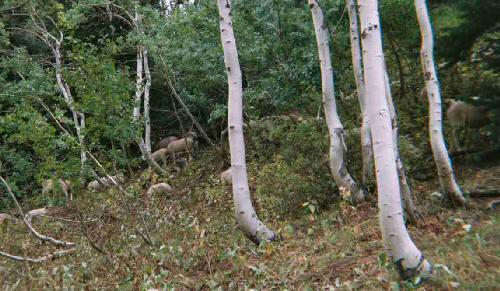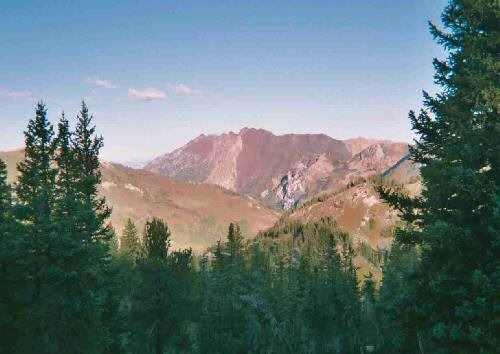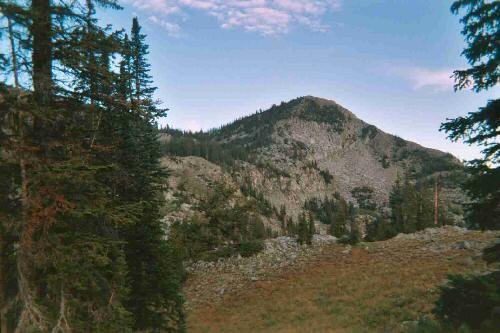Wasatch Front 100 Mile Run
Utah
September 6-7, 2003
By Brian McNeill

Are there Scots in Utah? Probably!
Bruce: It’s a fine day we’re havin!
Jimmy: Aye, an’ we a’ pay for it later!
Scots on the whole, are a people born expecting the worst. It’s nothing genetic as many other people who share much the same blood—Norwegians, Danes, Irish, and even God forbid, the English—manage to avoid the worst excesses of the Scottish temperment. If Americans see the glass as half full and can visualize getting rich by starting a chain of beverage outlets to fill the rest of the glass, my Scottish cousins see that it’s half empty and it’s a specimen cup besides.
Scots are conditioned by their history and the world around them to see things as they do. Their neighbors to the south invaded and deposed the Scottish monarchs almost at will for over a thousand years. Scots were usually unable to set aside internal bickering long enough to deal with the English. It’s not surprising that the cobination of pride, whisky, and edged weapons led to more than bruised feelings throughout the nation’s history. Even the nation’s greatest saga, that of William Wallace and the rise of Robert the Bruce, when finally told on-screen, was financed with American money, starred an Australian actor, and was filmed in Ireland. Just a few years ago, the Scottish National Team lost its opening round match of the World Cup to the Island of East Pongo, or some such place, four-nil. Scots were disappointed, but not surprised. It rains all the time, especially in the west. Is it any wonder that these people invented the distilling of spirits?
What does this have to do with the Wasatch Front 100 mile run? Well, the Wasatch course must have been designed by a Scot. Like the Scottish game of golf, trail-running purports to be a sport, but as practiced at Wasatch is really just an exercise in public humiliation and self-flagellation. Wasatch offers hour upon hour of laborious climbing, followed moments later by spine-compressing, toenail destroying descents. The reward for completing such a cycle is...the opportunity to do it again, and again, and again, only ever more slowly and painfully. There’s something about the inevitability of the up-and-down cycle that would have made a determinist such as John Knox lace up a pair of Montrails. The course is as stern and unforgiving as the Old Testament God much beloved of the “Wee Frees” from the Western Isles, and very well could have been designed by the devil himself.
The course begins in the dark in the Great Salt Lake Basin, about 10 miles north of Salt Lake City. Like many other sprawling areas such as Silicon Valley or L.A., it’s hard to tell where the city ends and the next suburb really begins. The course climbs gently for about four miles or so, giving runners the opportunity to warm up before the work begins in earnest. From four to nine miles, the trail grows steadily steeper, until the final ascent onto the ridge at Chinscraper, which is a final 30 to 50 foot scramble on all fours over loose scree to the top. By this point, runners will have climbed about 4,700 feet. The trail then meanders along the ridgeline above 9,000 feet for about eight more miles, before the first aid station at 18 miles, Francis Peak. I found the most annoying climb on the entire course to be a brief, nasty ascent of perhaps five-hundred feet just before the Bountiful B aid station. I slipped (but managed not to fall) several times on the ground that had been chewed up by a flock of sheep, which were lurking nearby, trying to look inconspicuous.
 Bountiful B (23 miles) to Big Mountain (39 miles) presents the best section on the course
both for photography and for running. It’s a long, rolling
stretch across grazing lands with few sustained climbs. I managed
barely better than three miles per hour on this section. Yes, I’m
slow, but I didn’t realize that I was quite that slow. I put
into the Big Mountain Aid Station at 4:45 in the afternoon, or in 10
hours and forty-five minutes. I arrived at about the same time as
Peyton Robinson, and Marty Lindemann helped both of us prepare for
the next 13 mile leg into Lamb’s Canyon, which I would reach at
9:15. I took my time, sitting down for the first time in the race,
and cutting tape off of my feet, cleaning and re-taping them.
Bountiful B (23 miles) to Big Mountain (39 miles) presents the best section on the course
both for photography and for running. It’s a long, rolling
stretch across grazing lands with few sustained climbs. I managed
barely better than three miles per hour on this section. Yes, I’m
slow, but I didn’t realize that I was quite that slow. I put
into the Big Mountain Aid Station at 4:45 in the afternoon, or in 10
hours and forty-five minutes. I arrived at about the same time as
Peyton Robinson, and Marty Lindemann helped both of us prepare for
the next 13 mile leg into Lamb’s Canyon, which I would reach at
9:15. I took my time, sitting down for the first time in the race,
and cutting tape off of my feet, cleaning and re-taping them.
It was on this same section that I first really experienced the rocks of the Wasatch Front. They’re not the jagged toe-slicers we know from Eastern Trails, protruding from the earth and waiting to snag the tired and inattentive. Rather, the grape-sized rocks of Utah are animated by some devilish force that sets them in motion whenever a human foot draws near. This makes downhill running a true test of faith. The final 20 miles of the race offers two aptly named descents, “the dive” and “the plunge.” My literary skills are tested in describing them adequately. Try to visualize Weaverton Cliffs without the switchbacks. Okay? Now make it steeper, and twice as long. Still okay? Good. Now cover it with loose golf balls. There you have “the dive” and “the plunge.”
I picked up my flashlight at Big Mountain and began the trek to Lamb’s Canyon, where I’d pick up my pacer. The weather had been gorgeous all day, and as I descended towards Alexander Springs Aid Station at 47 miles, I was treated to the sight of a distant thunderstorm lighting mountain ridges twenty or thirty miles away. Night set in just as I left the aid station. This was a very runnable section, but with the waning of the day, I just wanted to walk. I arrived at the major aid station at Lamb’s Canyon around 9:15, where I met my pacer, a local physical therapist named Kirk Dyches. Kirk regularly trains on the section that we were to cover at night, from Lamb’s Canyon to Brighton (52 to 75 miles). He also intends to enter Wasatch next year. Kirk’s knowledge of the course was a terrific asset. I didn’t have to navigate. He knew every turn, every climb, and every landmark on this section. It was a great relief just to walk and/or run and not worry about getting lost. I felt much better now that I had some company. I use a flashlight with 14 green LEDs and a four white-LED headlamp. The combination of the two lights is a great system as it helps produce shadow, providing some measure of depth-perception, which I find lacking when using only a single lighting source. I lent Kirk a 7-LED flashlight for the night, which he used in addition to his headlamp, and together we could really illuminate the trail well enough to run the single track with confidence. We must have passed two-dozen runners on the descent from Upper Big Water to Desolation Lake (61 to 66 miles) as the lights and the company rejuvenated me.
It was on the gradual climb from Desolation Lake to Scotts Pass Aid Station (66 to 70 miles) that I began to notice fluid build-up in my lungs. I suffer from mild respiratory system problems, which could be characterized as EIA, and I initially ascribed the symptoms to the intense dust of the earlier sections of the course. The watery rattle that my chest produced as we climbed towards 10,000 feet at Red Lover’s Ridge was more significant than a little dust, though.
I tried taking caffeine tablets during a race for the first time. Even so, I had problems with sleep deprivation beginning on the ascent to Scott’s Pass around 2:00 a.m. I grew sloppy and lethargic on the rocky road. When we entered Scott’s Pass Aid Station, I told Kirk that I needed to sit and close my eyes for just a couple of minutes. I sat down, threw a sleeping bag over my head to drown out all the surrounding din, and closed my eyes for about 4 or 5 minutes. As approaching thunder grew near, I decided that I could manage to stay awake long enough to reach Brighton, which is a major (indoor) aid station at mile 75. About ½ mile before Brighton, the storm arrived, pelting us with wind-driven, pea-sized hail and rain. We ran into the ski-resort, drenched, but still not chilled to the bone. As most of the people behind me didn’t pass me again and I finished near the back of the pack, I can only assume that most of them had to drop owing to hypothermia or timing issues because of the storm. Kirk and I said our goodbyes, and he headed home to a well deserved sleep. I changed clothes, forced down some hot food (nothing appeared appetizing at this point), and took a fitful nap of about 45 minutes seated at one of the tables in the lodge, while I waited for the storm to pass.
 I departed Brighton at
6:58 (after 1:14 in the aid station) on a brilliant, clear morning
and began the short, steep climb up Catherine’s Pass to Point
Supreme, and the highest point on the course. As an Easterner, who’d
never been above 6,000 feet except in an airplane, the altitude
became an issue. What I thought was a little wheezing was clearly
more than that. I must have looked like Rheinhold Messner or Rick
Ridgway ascending some 20K peak without oxygen. I would take four or
five steps, cough, spit, breathe, and then take four or five more
steps and repeat. That’s how I ascended both Point Supreme and
the Grunt (mile 82), the two toughest climbs in the last 25 miles of
the course.
I departed Brighton at
6:58 (after 1:14 in the aid station) on a brilliant, clear morning
and began the short, steep climb up Catherine’s Pass to Point
Supreme, and the highest point on the course. As an Easterner, who’d
never been above 6,000 feet except in an airplane, the altitude
became an issue. What I thought was a little wheezing was clearly
more than that. I must have looked like Rheinhold Messner or Rick
Ridgway ascending some 20K peak without oxygen. I would take four or
five steps, cough, spit, breathe, and then take four or five more
steps and repeat. That’s how I ascended both Point Supreme and
the Grunt (mile 82), the two toughest climbs in the last 25 miles of
the course.
 After the awful, rock
strewn descent from Catherine’s Pass, I reached Ant Knolls, and
then re-ascended a finger of the ridge pointing east from
Catherine’s, called “the grunt.” Short but very
steep, this climb forced me to stop several times to clear my chest
before proceeding. A series of pleasant, sun-covered ridges, led me
to the Pole Line Pass Aid Station (mile 83 and 10:18 in the morning),
where a breakfast of hot-cakes and syrup awaited (two plates!) Here
I saw Mike Bur, who arrived at nearly the same time, but who left
five-to-ten minutes prior to my own departure. I wouldn’t see
him again, as he finished nearly an hour ahead.
After the awful, rock
strewn descent from Catherine’s Pass, I reached Ant Knolls, and
then re-ascended a finger of the ridge pointing east from
Catherine’s, called “the grunt.” Short but very
steep, this climb forced me to stop several times to clear my chest
before proceeding. A series of pleasant, sun-covered ridges, led me
to the Pole Line Pass Aid Station (mile 83 and 10:18 in the morning),
where a breakfast of hot-cakes and syrup awaited (two plates!) Here
I saw Mike Bur, who arrived at nearly the same time, but who left
five-to-ten minutes prior to my own departure. I wouldn’t see
him again, as he finished nearly an hour ahead.
While I was well over an hour ahead of the cut-offs, time was beginning to concern me, as I had once had over two hours in the bank. I fell into line with a group of four runners from the Salt Lake City area and stayed with them throughout most of the next 8 miles. They’d pull away as I wheezed to the top of a climb, and I’d catch them on the down hills. As we arrived at the final big descent into Pot Bottom (93 miles), I decided to stretch it out, and passed them, arriving at the aid station at 2:16 in the afternoon and departed just as they arrived. I climbed my way out of the canyon to the crest of the final ridge before the finish, with about 5 miles to go.
I realized then that I was going to finish the race, barring a disaster. That realization led me to slow significantly, as I realized that I no longer needed to push; I simply needed to get to the finish line. Consequently, these four runners passed me, as did another three or four runnners on the final ½ mile on the road, just before the finish line. Normally, I like to finish strong and try to pick-off runners as I get closer to the end, but in this case, I didn’t care. I simply walked and anticipated the glory of a hot shower and clean clothes. I managed to break into a run within eye-sight of the finish line, but my heart wasn’t really in it. It mattered little to me whether I finished in 120th or 125th place—I had finished in a time of 35:20, which is ten minutes less than the estimated time I had submitted on my entry form, although about an hour slower than my hoped-for finish time of 34:30.
Special thanks to my pacer Kirk Dyches, to Marty Lindemann, to Peyton Robinson, and to Russ Evans for their help and support. I sorely needed lots of help to complete this race. I needed to err in favor of significant training, preparation, and support in order to have a chance to finish, as I have little native athletic ability to draw upon.
The Wasatch course is made for a Scot. It promises nothing good. It is arduous. It rewards stoic patience rather than flashy brilliance. I finished because I had resolved during my training that no matter what happened, I simply would not quit. Never. No matter what. I resolved that I would have to be pulled for medical reasons or because of timing-out before leaving the course. Although I generally take a more moderate position than do my ancestors, my family motto of “Buaidh No Bas!” translates as “Conquer or Die!” so it makes sense.
I don’t think I will do Wasatch again. While it is indeed beautiful, I can’t imagine putting myself through such a difficult challenge again. Not only the race, but the past summer’s training put stress on my body, my overall health, my marriage, and my wallet. I think this race goes into the category of “That was wonderful; thank God I finished and don’t have to go back there.” I run as a relief from deadlines, deliverables, project plans, and conference calls. My pursuit of a finisher’s award and cowboy-sized belt buckle became altogether too much like work to be much fun towards the end. Grand Slammer, Mike Bur also seemed to embody the effects of too much of a good thing with his pre-race declaration of “let’s get this over with” on the ride to the start-line.
I still have peripheral neuropathy in my right foot (residual numbness) owing to the cumulative trauma to the soft tissue in my feet, which pinched the nerves. That should sort itself out over the next week or two. Other than that, I have nary an ache or a complaint. I should be able to start running again later this week. I experienced blister problems earlier in the year, but following my near disaster at Mohican as a consequence of blisters, I adopted Suzi Cope’s taping system, as described in John Vonhof’s book, Fixing Your Feet. Since then, not a single blister of any significance has appeared on my feet.
Virginia Happy Trails Running Club
Home | News | Events | Membership | Members Only | Photos
Bull Run Run 50 | Massanutten Mt. Trails 100 | Training Runs | Links
Feedback